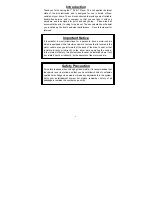
118
EN
IV. Assembling
the generator
y
After removing the generator from the box, place it on
a rigid level surface and install the wheels, the base and
the handles on to the frame as shown in fig. 6a to 8. This
does not apply to model 8896317 since this model only
has implanted rubber legs (does not have transport wheels
and handles) Put the supplied pads in the respective locati-
ons, secure the wheels that are slid on the axle by inserting
the cotter pins. Securely tighten all bolt/screw connections.
CONNECTING THE EL. START-UP BATTERY
1) Remove the protective plastic caps from the
battery terminals and before connecting the
cables we recommend measuring the voltage
on the battery terminals using a multimeter to
determine whether it is flat.
For your information, we have provided the battery vol-
tage values in relation to the charge level in table 2.
Battery power level
Battery terminal voltage
100%
12.90 V to 14.4 V
75%
12.60 V
50%
12.40 V
25%
12.10 V
0%
11.90 V
Table 2
y
We recommend maintaining the battery fully charged. In
the event that the battery is less charged, or discharged,
for an extended period of time, its lifetime is significan-
tly reduced, its ability to start the generator is impaired
and also its ability to be regenerated by an intelligent
microprocessor-controlled battery charger is limited
if the charger is equipped with a battery regeneration
function. Apart from requiring charging, when the bat-
tery is not regularly recharged by the operation of the
generator, the battery is entirely maintenance-free and
no tampering is permitted. In the event that the battery
is completely flat for an extended period of time, it will
be necessary to replace it with a new one (for the part
number of the replacement battery, see table 1).
Note:
y
When the generator is running, the battery is automa-
tically recharged in the same way as a car battery in
a motor vehicle. In the event that the generator has not
been used for an extended period of time, the battery
is not being recharged and it naturally self-discharges,
which is further exacerbated when the cables are con-
nected to the battery. In the event that the generator
has not been in operation for a long time (the battery
is not regularly recharged), we recommend that the
battery cables are disconnected and then to connect an
intelligent microprocessor-controlled charger with pulse
charging with a charging current of 1-2 A to the battery
in order to keep it fully charged. A microprocessor-con-
trolled charger with pulse recharging will automatically
recharge a battery when the terminal voltage of the
battery declines and will stop charging once the battery
is recharged (overcharging cannot occur).
y
In the event that it is necessary to charge the battery,
then we recommend using an intelligent microprocessor-
-controlled charger with a charging current in the range
1-2 A, e.g. microprocessor-controlled charger Extol® Craft
417301 with a charging current of 1 A, which automati-
cally monitors and evaluates the battery charge level and
it is not possible to overcharge the battery, which is very
important for safety and the lifetime of the battery.
y
The terminal voltage on gel batteries should not exce-
ed 14.4 V, which intelligent microprocessor-controlled
chargers ensure or should ensure (if they are of good
quality). For safety reasons, with respect to the capacity
of the battery, a charger with a charging current greater
than 2 A should not be used, since the battery is unable
to "suddenly handle" the higher charging current and
this causes the "false" charge effect, where the battery
will be fully charged for a short time after being discon-
nected from the charger, but then the terminal voltage
will quickly decline; and the use of a high charging cur-
rent may result in the battery exploding. Rapid "false"
charging of the battery by means of an excessively high
charging current shortens the lifetime of the battery.
y
In the event that a charger without automatic control is
used to charge the battery, it is necessary to regularly
measure the battery terminal voltage with the charging
cables disconnected from the battery, in order to ensure
that it does not exceed 14.4 V.
y
In the event that the generator is not operated for a suf-
ficiently long time and the battery is not connected to
a microprocessor-controlled charger with pulse char-
ging, disconnect the cables from the battery to mini-
mise the natural self-discharge effect and to ensure the
longest possible lifetime for the battery. Fully charge the
battery after several months and during the charging
process monitor that the battery's terminal voltage does
not exceed the voltage of 14.4 V (if the charger does not
have automatic control of operation).
y
Further useful information about lead batteries can
be found in the documents titled "Guide to the world
of lead batteries", which is available at the website of
HERON® after entering the part number of the generator
into the search engine or we can, upon request, provide
it at our customer service centre.
2) Using the supplied bolts, connect the red cable
to the positive battery terminal with the mar-
king "+" and the black cable to the negative ter-
minal with the marking "–". Firmly tighten the
bolt connections and regularly check that they
are tight to prevent them from coming loose.
•
ATTENTION
y
In the case of models 8896318 and 8896319, which have
a battery mounting clamp (fig. 3, position 1), do not place
the cables underneath this clamp because due to the
















































